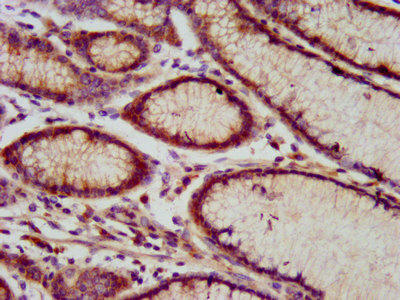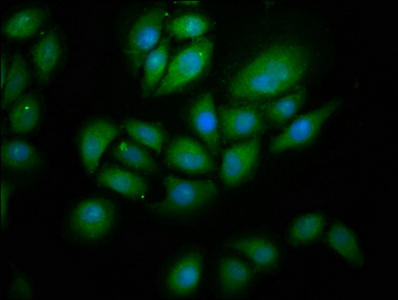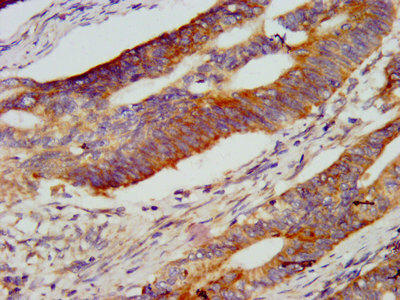Description
| Antibody Name: | RNF213 Antibody (PACO57188) |
| Antibody SKU: | PACO57188 |
| Size: | 50ug |
| Host Species: | Rabbit |
| Tested Applications: | ELISA, IHC, IF |
| Recommended Dilutions: | ELISA:1:2000-1:10000, IHC:1:500-1:1000, IF:1:200-1:500 |
| Species Reactivity: | Human |
| Immunogen: | Recombinant Human E3 ubiquitin-protein ligase RNF213 protein (202-350AA) |
| Form: | Liquid |
| Storage Buffer: | Preservative: 0.03% Proclin 300 Constituents: 50% Glycerol, 0.01M PBS, pH 7.4 |
| Purification Method: | >95%, Protein G purified |
| Clonality: | Polyclonal |
| Isotype: | IgG |
| Conjugate: | Non-conjugated |
 | IHC image of PACO57188 diluted at 1:800 and staining in paraffin-embedded human gastric cancer performed on a Leica BondTM system. After dewaxing and hydration, antigen retrieval was mediated by high pressure in a citrate buffer (pH 6.0). Section was blocked with 10% normal goat serum 30min at RT. Then primary antibody (1% BSA) was incubated at 4°C overnight. The primary is detected by a biotinylated secondary antibody and visualized using an HRP conjugated SP system. |
 | Immunofluorescence staining of A549 cells with PACO57188 at 1:266, counter-stained with DAPI. The cells were fixed in 4% formaldehyde, permeabilized using 0.2% Triton X-100 and blocked in 10% normal Goat Serum. The cells were then incubated with the antibody overnight at 4°C. The secondary antibody was Alexa Fluor 488-congugated AffiniPure Goat Anti-Rabbit IgG(H+L). |
 | IHC image of PACO57188 diluted at 1:800 and staining in paraffin-embedded human colon cancer performed on a Leica BondTM system. After dewaxing and hydration, antigen retrieval was mediated by high pressure in a citrate buffer (pH 6.0). Section was blocked with 10% normal goat serum 30min at RT. Then primary antibody (1% BSA) was incubated at 4°C overnight. The primary is detected by a biotinylated secondary antibody and visualized using an HRP conjugated SP system. |
| Background: | E3 ubiquitin-protein ligase involved in angiogenesis. Involved in the non-canonical Wnt signaling pathway in vascular development: acts by mediating ubiquitination and degradation of FLNA and NFATC2 downstream of RSPO3, leading to inhibit the non-canonical Wnt signaling pathway and promoting vessel regression. Also has ATPase activity. |
| Synonyms: | E3 ubiquitin-protein ligase RNF213 (EC 2.3.2.27) (EC 3.6.4) (ALK lymphoma oligomerization partner on chromosome 17) (Mysterin) (RING finger protein 213) (RING-type E3 ubiquitin transferase RNF213), RNF213, ALO17 C17orf27 KIAA1554 KIAA1618 MYSTR |
| UniProt Protein Function: | RNF213: Probable E3 ubiquitin-protein ligase that may play a role in angiogenesis. May also have an ATPase activity. Defects in RNF213 are the cause of susceptibility to Moyamoya disease type 2 (MYMY2). A progressive cerebral angiopathy characterized by bilateral intracranial carotid artery stenosis and telangiectatic vessels in the region of the basal ganglia. The abnormal vessels resemble a 'puff of smoke' (moyamoya) on cerebral angiogram. Affected individuals can develop transient ischemic attacks and/or cerebral infarction, and rupture of the collateral vessels can cause intracranial hemorrhage. Hemiplegia of sudden onset and epileptic seizures constitute the prevailing presentation in childhood, while subarachnoid bleeding occurs more frequently in adults. A chromosomal aberration involving ALO17 is associated with anaplastic large-cell lymphoma (ALCL). Translocation t(2;17)(p23;q25) with ALK. 4 isoforms of the human protein are produced by alternative splicing.Protein type: Ubiquitin conjugating system; EC 6.3.2.-; OncoproteinChromosomal Location of Human Ortholog: 17q25.3Cellular Component: membrane; cytoplasm; nucleolusMolecular Function: zinc ion binding; ATPase activity; ubiquitin-protein ligase activity; ligase activityBiological Process: protein autoubiquitination; protein ubiquitination |
| UniProt Protein Details: | |
| NCBI Summary: | This gene encodes a protein containing a C3HC4-type RING finger domain, which is a specialized type of Zn-finger that binds two atoms of zinc and is thought to be involved in mediating protein-protein interactions. The protein also contains an AAA domain, which is associated with ATPase activity. This gene is a susceptibility gene for Moyamoya disease, a vascular disorder of intracranial arteries. This gene is also a translocation partner in anaplastic large cell lymphoma and inflammatory myofibroblastic tumor cases, where a t(2;17)(p23;q25) translocation has been identified with the anaplastic lymphoma kinase (ALK) gene on chromosome 2, and a t(8;17)(q24;q25) translocation has been identified with the MYC gene on chromosome 8. Alternative splicing results in multiple transcript variants. [provided by RefSeq, Dec 2011] |
| UniProt Code: | Q63HN8 |
| NCBI GenInfo Identifier: | 597709777 |
| NCBI Gene ID: | 57674 |
| NCBI Accession: | NP_001243000.2 |
| UniProt Secondary Accession: | Q63HN8,Q658P6, Q69YK7, Q6MZR1, Q8IWF4, Q8IZX1, Q8IZX2 Q8N406, Q8TEU0, C9JCP4 |
| UniProt Related Accession: | Q63HN8 |
| Molecular Weight: | 64,260 Da |
| NCBI Full Name: | E3 ubiquitin-protein ligase RNF213 isoform 3 |
| NCBI Synonym Full Names: | ring finger protein 213 |
| NCBI Official Symbol: | RNF213 |
| NCBI Official Synonym Symbols: | ALO17; MYMY2; MYSTR; NET57; C17orf27; KIAA1618 |
| NCBI Protein Information: | E3 ubiquitin-protein ligase RNF213; mysterin; ALK lymphoma oligomerization partner on chromosome 17 |
| UniProt Protein Name: | E3 ubiquitin-protein ligase RNF213 |
| UniProt Synonym Protein Names: | ALK lymphoma oligomerization partner on chromosome 17; Mysterin; RING finger protein 213 |
| Protein Family: | E3 ubiquitin-protein ligase |
| UniProt Gene Name: | RNF213 |
| UniProt Entry Name: | RN213_HUMAN |






